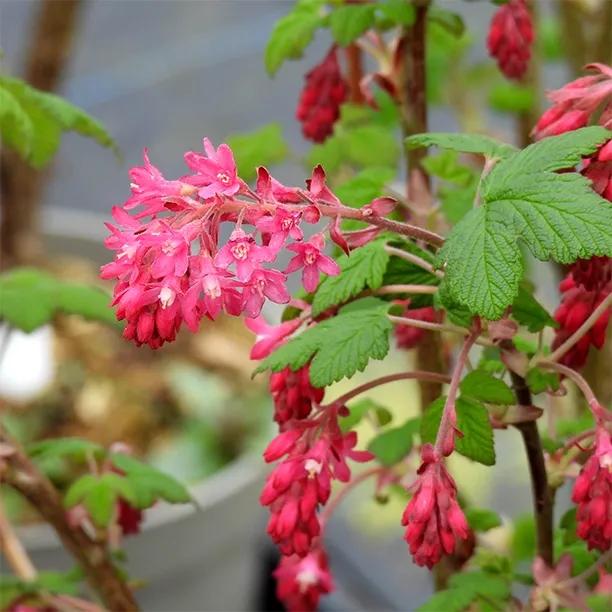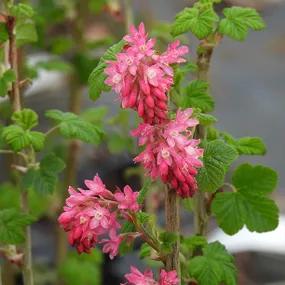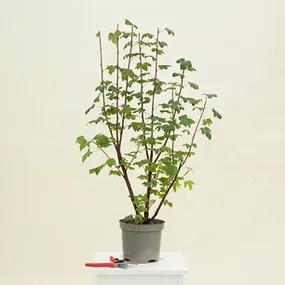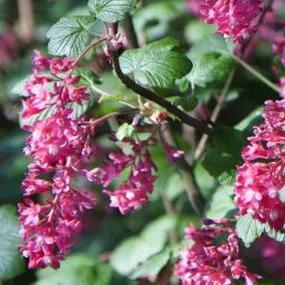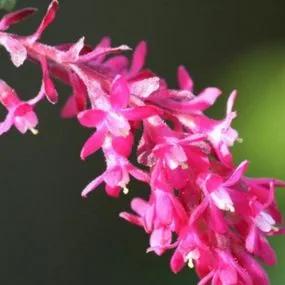Flowering Currant Plants, King Edward VII
Honest Delivery PricesRibes sanguineum 'King Edward VII'
- Dark pink flowers, scented leaves, edible fruit.
- Blooms late March to April
- Good ornamental shrub, or in mixed hedges.
- RHS Plants for Pollinators
- Max. Height: 3m
- Bareroot Delivery: Nov-Mar
Recommended extras
Description
Ribes Sanguineum King Edward VII Hedging
Delivered by Mail Order Direct from our Nursery with a Year Guarantee
Ribes King Edward VII, is a pretty flowering shrub that makes a good informal hedging plant. It will grow on any soil with decent drainage.
Ribes King Edward VII is good for hedges up to about 2-3 metres high.
Fruit: It does produce edible fruit, but honestly we would leave them for the birds: they are nowhere near as nice as the big crops of delicious currants you'll get from our varieties of red, white or blackcurrant plants!
Ribes King Edward VII hedge plants are delivered bareroot during winter (Nov-March) and pot-grown year round.
Bareroot bushes are cheaper than pot grown plants. Pot grown plants are available in the largest sizes.
See our selection of hedge shrub plants or view our full range of hedging.
Choosing a size:
When you are ordering Ribes King Edward VII plants for a hedge, we generally recommend that you use the smaller, bareroot plants. They are cheaper than the larger, pot-grown plants, easier to handle and they will establish well in poor conditions.
Use the bigger, pot-grown plants if you want a taller hedge quickly or for instant impact as a specimen shrub.
All our hedge plants are measured by their height in centimetres above the ground (the roots or pots aren't measured).
Spacing a Ribes King Edward VII hedge:
Plant Ribes King Edward VII hedging at 3 plants per metre, 33cm apart.
General description of Ribes King Edward VII plants:
This ornamental currant is an elegant shrub carrying strongly scented dark pink, almost purple, flowers in April and dark berries in summer. These are edible, but they don't taste as good as a proper fruiting currant.
This is an excellent plant for difficult positions as it grows in just about any soil. It can be used as a specimen shrub or an informal single species hedge. For a secure hedge, we advise interplanting it with a tough, thorny plant like hawthorn or blackthorn.
Did You Know?
This North American species has been growing wild in Britain since the first half of the 1800's. This variety was bred during the reign of Queen Victoria, but she died before it was released, and it was named after the new king.
Planting Instructions
Growing Ribes King Edward VII plants:
Ribes King Edward VII will grow well in pretty much any reasonably fertile, well drained soil. It needs full sun to grow well and produce lots of flowers, but it is fully hardy and will grow close to the sea as long as the soil isn't too thin and sandy.
Prepare your site before planting:
It is good to dig over the area where you plant a hedge several months in advance, especially if the soil is poor. Destroy the weeds first: nettles, brambles and ground elder are tough. Then dig the soil over; remove rocks, roots and other rubbish. Mix in well rotted compost or manure down to the depth of about 2 spades. If your soil is rich, you don't have to dig it over, but killing all the weeds is still necessary.
Watch our video on how to plant a garden hedge for full details. The plants in this video are delivered pot-grown, but planting out bareroot stock is essentially the same.
Remember to water establishing plants during dry weather for at least a year after planting.
Hedge Planting Accessories:
Prepare your site for planting by killing the weeds and grass.
You can buy a hedge planting pack with sheets of mulch fabric and pegs to hold it down.
If you are planting in an area with rabbit and/or deer, you will need to use a plastic spiral guard for each plant, supported by a bamboo cane.
If your soil quality is poor, we recommend using mycorrhizal "friendly fungi" on the roots of new trees and shrubs.
You can also improve your soil with bonemeal organic fertiliser.
After Care
After you have planted your Ribes King Edward VII hedge, the most important thing to do is water it in dry weather. You will also need to weed around the plants. Watering should be thorough, so the ground is soaked. Let the soil almost dry out before watering again. Watering & weeding will be necessary for at least a year after planting.
Trimming Formal hedge plants:
Ribes King Edward VII is naturally bushy, so it doesn't need any clipping at all in its first year. In the winter of the following year, your young hedge should be trimmed lightly and every winter after that until it is mature.
When it is fully grown, you can clip it at anytime. A good time to clip Ribes King Edward VII hedges is after flowering.
Special notes on caring for Ribes King Edward VII hedges:
Ribes King Edward VII is a tough hedge plant that shouldn't need special attention once it has established. If you didn't use a mulch fabric, it is beneficial to mulch around the base of the hedge each year.
Hygiene & Diseases:
Dead, damaged or diseased wood can be pruned off as soon as it appears.
Disinfect your pruning tools between every cut if there is any sign of disease.
Burn or dispose of any diseased material, do not compost it.
After you have planted your Ribes King Edward VII hedge, the most important thing to do is water it in dry weather. You will also need to weed around the plants. Watering should be thorough, so the ground is soaked. Let the soil almost dry out before watering again. Watering & weeding will be necessary for at least a year after planting.
Trimming Formal hedge plants:
Ribes King Edward VII is naturally bushy, so it doesn't need any clipping at all in its first year. In the winter of the following year, your young hedge should be trimmed lightly and every winter after that until it is mature.
When it is fully grown, you can clip it at anytime. A good time to clip Ribes King Edward VII hedges is after flowering.
Special notes on caring for Ribes King Edward VII hedges:
Ribes King Edward VII is a tough hedge plant that shouldn't need special attention once it has established. If you didn't use a mulch fabric, it is beneficial to mulch around the base of the hedge each year.
Hygiene & Diseases:
Dead, damaged or diseased wood can be pruned off as soon as it appears.
Disinfect your pruning tools between every cut if there is any sign of disease.
Burn or dispose of any diseased material, do not compost it.

